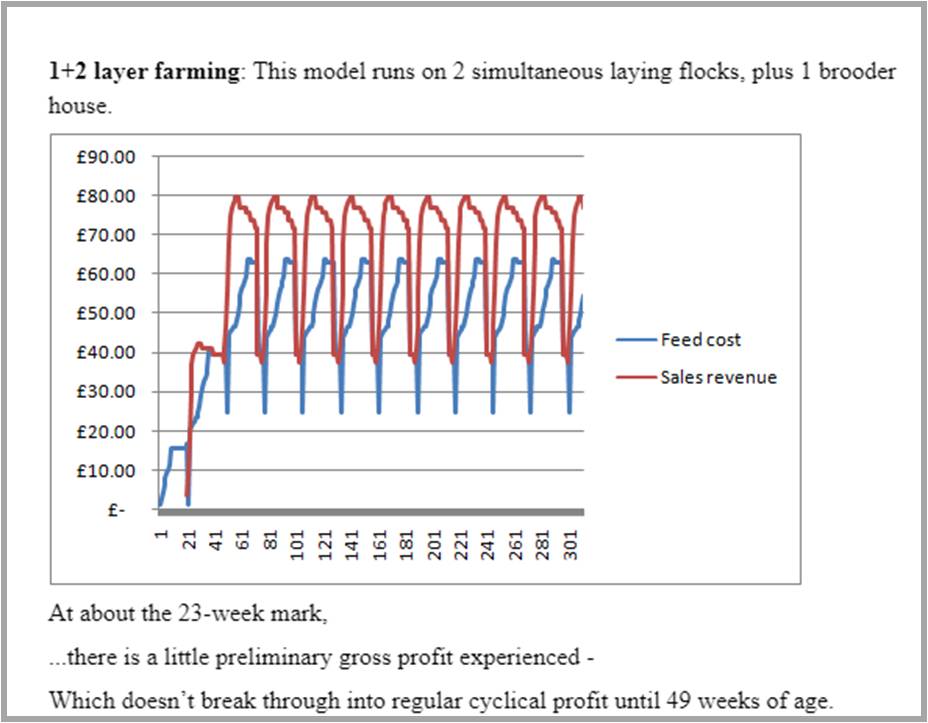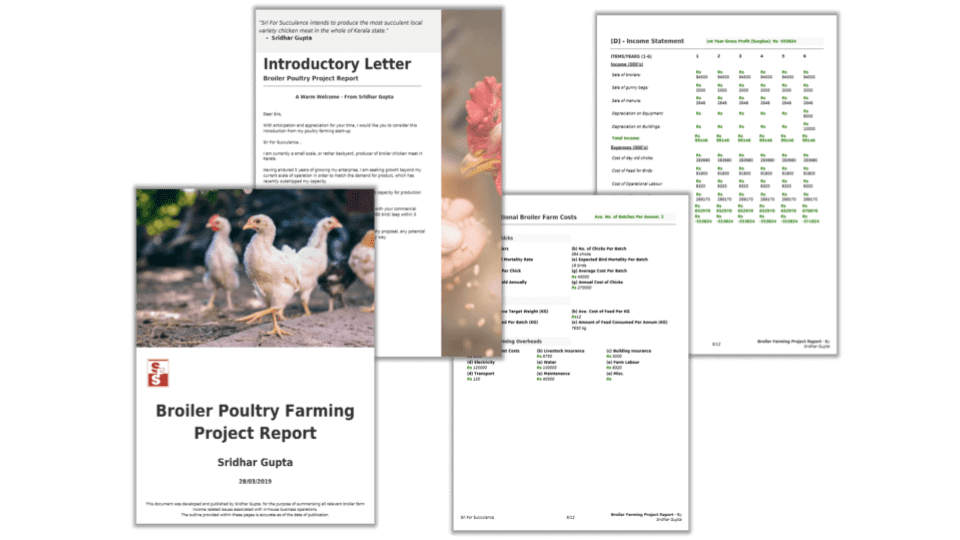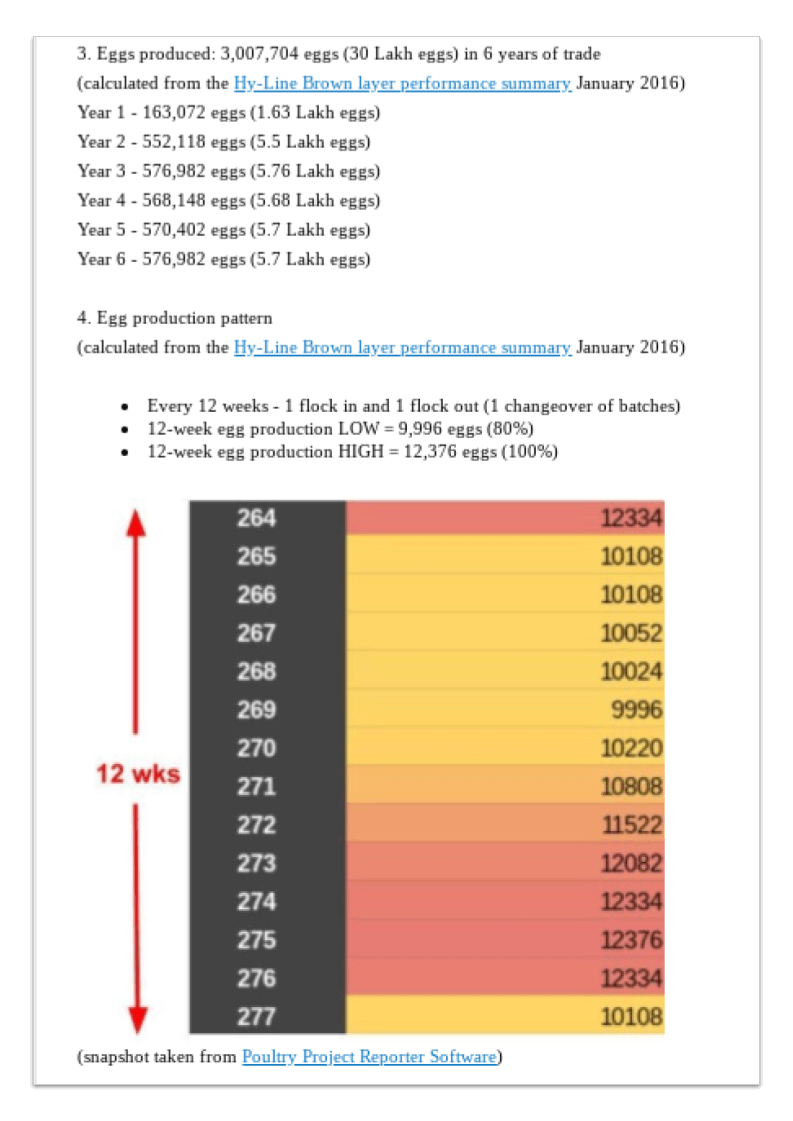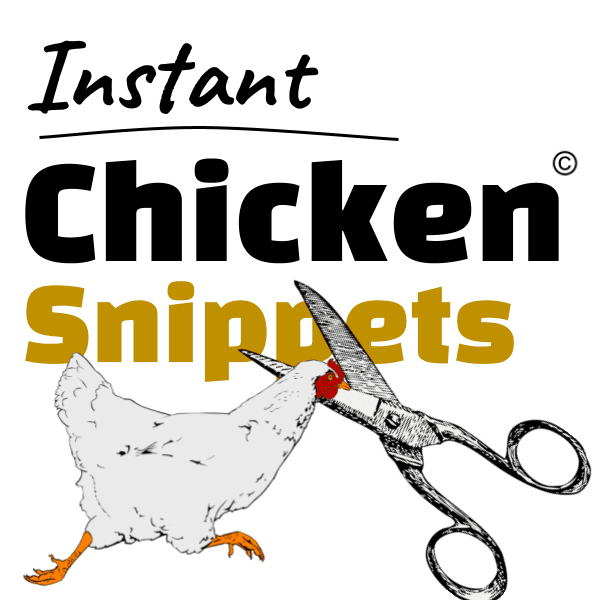
Today, I’m going to explain how the most common multi-flock layer farming models work.
And I’ll compare the features of each model…
…highlighting their importance for your layer farming business plans.
The aim?
The help you understand the benefits of each.
And make the most profitable decision for your business planning.
Single flock vs. multi-flock system
When rearing layers (and broilers alike) you have two main choices of rearing model.
[I cover this briefly, in this chapter “Projecting Layer Egg Production” of my free poultry farming eBook]
Single flock or multi-flock.
In other words,
a) Rearing one flock at a time on your farm…
…or,
b) rearing more than one flock on your farm, simultaneously.
But why choose one over the other?
Here are the pros and cons of single flock layer farming vs. multi-flock models:

Write Your Poultry Business Plan -
in Just 90 Mins!
Poultry Project Reporter 2.0 - fastest way to write your project report online.
Get Poultry Project Reporter 2.0Single-flock layer farming
Pros of single-flock rearing model
- Simplicity:
- one single flock to manage at one time, so all husbandry efforts and focus lay upon one batch of birds ONLY.
- Biosecurity:
- much-reduced chance of cross-contamination. The only scope for cross-infection would be exposing the new entrant flock to contaminants left behind from the old spent flock.
- Lower construction capital cost:
- one poultry house required only. Therefore, you only need to invest in the construction of one house.
- Lower labour overhead:
- only none poultry house to maintain by staff reduces labour burden.
- Lower cleaning cost:
- no duplication of efforts on your farm. In between removing a spent flock and accepting a new flock – you only have one birdhouse to deep clean.
Cons of single flock rearing model
- Production constraints:
- the number of eggs you can produce is hindered by (a) only rearing one flock and (b) the farm’s entire production output being constrained to the hen day egg production of one, single age flock.
- Cash flow interruptions:
- whether you choose to buy point-of-lay birds or day-old chicks, you’ll lose some egg productivity, when the age of the flock is either side of their peak laying potential.
- Delayed ROI:
- with the constraints mentioned above, this model will therefore delay ROI potential in the long run. You simply won’t recoup as much money, as quickly as multi-flock models.
Multi-flock layer farming
Pros of multi-flock rearing model
- Enhanced production:
- more eggs overall, more consistent volumes of production (smoother) – not suffering dips when flocks are either side of their peak laying ages.
- Cash flow consistency:
- smooth cash flow. The volume of eggs available for sale is within a far narrow band of variance.
- Better ROI:
- the mounting investment benefits offer a quicker route to ROI (return on investment).
Cons of multi-flock rearing model
- Complexity:
- you have to manage more than one flock at one time, each having its own distinct needs (also, influenced by age difference).
- Contamination risk:
- there is a cross-contamination risk when holding more than one flock.
- Higher construction capital cost:
- each batch of birds will occupy a separate birdhouse. So, for example, rearing 3 flocks will require you to provide 3 separate birdhouses.
- Higher labour overhead:
- stockmen work most efficiently when the workflow is simplified. The more moving around the site, the less efficient their work and the more labour expense.
- Higher cleaning cost:
- When housing multiple flocks you also multiply your deep cleaning at the ‘end of tenancy’ of a spent flock.
How multi-flock layer farming models work…
Multi-flock layer farming is common practice around the world.
The idea of raising more than one egg-laying flock at one time has its advantages (shown above).
But what are the popular models & how do they ACTUALLY work?
Here is a detailed breakdown:
1+2 Layer farming model
Definition:
- 1 brooder flock – in 1 brooder house
- plus 2 layer flocks – each flock in its own layer house
- So, 3 birdhouses in total
How it works:
- Decide on your batch size…i.e. 1,250 birds per batch, so 2x layer batches = 2,500 layer farm
- You buy your flocks 28 weeks apart.
- New flocks of day-old chicks are introduced into the brooder house
- At point-of lay, the birds are transferred from the brooder house into one of the 2 layer houses
- The process is repeated 28 weeks later plus the weeks until both layer houses are occupied with laying hens (and the brooder house is also occupied)
- This process continues, removing spent hens at 70-74 weeks old (which make way for new point-of-lay grower hens)
1+3 Layer farming model
Definition:
- 1 brooder flock – in 1 brooder house
- plus 3 layer flocks – each flock in its own layer house
- So, 4 birdhouses in total
How it works:
- Decide on your batch size…i.e. 833 birds per batch, so 3x layer batches = 2,499 layer farm
- You buy your flocks 20 weeks apart.
- New flocks of day-old chicks are introduced into the brooder house
- At point-of lay, the birds are transferred from the brooder house into one of the 3 layer houses
- The process is repeated 20 weeks later plus the weeks until both layer houses are occupied with laying hens (and the brooder house is also occupied)
- This process continues, removing spent hens at 70-74 weeks old (which make way for new point-of-lay grower hens)
1+1+5 Layer farming model
Definition:
- 1 brooder flock, in 1 brooder house
- 1 grower flock, in 1 grower house
- plus 5 layer flocks – each flock in its own layer house
- So, 7 birdhouses in total
How it works:
- Decide on your batch size…i.e. 500 birds per batch, so 5x layer batches = 2,500 layer farm
- You buy your flocks 12 weeks apart.
- New flocks of day-old chicks are introduced into the brooder house
- At point-of lay, the birds are transferred from the brooder house into one of the 5 layer houses
- The process is repeated 12 weeks later plus the weeks until all layer houses are occupied with laying hens (and both brooder house and grower house is also occupied)
- This process continues, removing spent hens at 70-74 weeks old (which make way for new point-of-lay grower hens)
Conclusion
As you can probably imagine, the more houses you have – the more eggs your farm will produce.
So, these multi-flock models offer ways of increasing your output.
And they do this whilst keeping your overall layer hen headcount (capacity) the same.
It’s like adding gears to your bicycle.
Makes for a much smoother and easier ride, for the same effort.
Not bad, huh?
Whilst this IS a good introduction to the theory of multi-flock layer farming,
What it doesn’t give you is a factual example of the kind of figures you should expect from these types of strategies.
It lacks some sample numbers to help you build your own plan.
Want to see a sample plan using these models above?
I’ve got just the thing for you.
PPR 2.0 Insider’s Guide.


It is the egg by egg, pound by pound sample plan for what kind of output and gross profit these models can give you.
Subscribe now to access The Insider’s Guide for sample multi-flock models to download.

I like how the eggs sample plan shows a high growth after multi layering your flock. at first I was interested in the single-flock model because it enables the farmer to give ample attention to the flock. however, since my goal is profit at the end of the day. I think the multi-flock model is what I would like to adopt as time goes by.
Hello Nokulunga,
Good point. Undivided attention does promote focus and results. But profit sustains.
Perhaps for 1st-timers getting it right is more of a challenge so a single flock model would ease one in.
But as experience and confidence build, then improving cash flow with multiple flocks will help the ROI-growth process.
A great point to add.
Thanks for stopping by.
Dear Big Book Project team,
I hope you are all well. Please assist me estimate the number of eggs produced in a 1+3 layer rearing house system where each batch is 1,250 over a period of 6 years. Your support is greatly appreciated.
Thanks
Team Big Book project, please assist me understand how to calculate the feeding costs and total egg production for a 1+3 layer hand housing system of poultry farming. Your support is much appreciated.